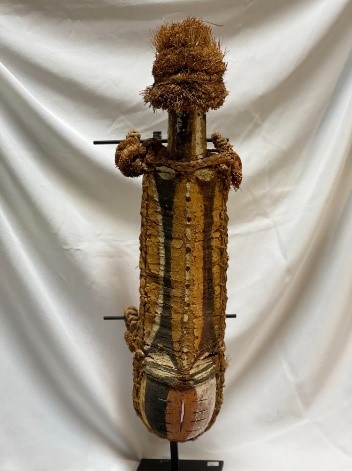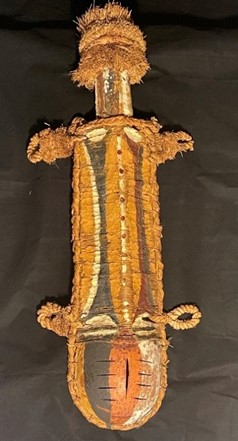The Igbo men of Nigeria create Isiji initiation masks with a wooden frame to form the tall upper section and a calabash gourd to form the face mask. The frame is tightly wound and tied with raffia rope and fibers, and more raffia is braided and tied around the edges of the mask to form a border and side loops. The mask is painted with red, black, white, and yellow mineral pigmented clay. When the mask is about to be danced, dark green leaves are added to the raffia ball at the top, which harmoniously blend with the light green raffia garment that covers the dancer from his neck to his ankles. Straps are also tied to the side loops of the mask to provide handles, so the dancer may easily balance the mask upright.
The Isiji mask is worn by the eldest son of a family during his initiation into the community’s secret society, which all Igbo men are required to join at maturity. After days of secluded preparation, the young man performs a dance of endurance in front of the men and women of their Igbo community. Other masked boys and men may join in the dancing and singing while they play percussion with sticks and drums. The Isiji mask is believed to hold sacred powers and to show a spiritual connection with the ancestors.

Isiji Initiation Mask
Igbo culture
Early 20th century
Wood, calabash, mineral pigments, thaumatococcus leaves, and raffia
L. 7.5 cm x W. 23 cm x H. 70.5 cm
MSU collection #2018.1.8

Isiji Initiation Mask
Igbo culture
Early 20th century
Wood, calabash, mineral pigments, thaumatococcus leaves, and raffia
L. 7.5 cm x W. 23 cm x H. 70.5 cm
MSU collection #2018.1.8
For more information, you may contact the researcher(s) noted in the title of this exhibit entry, or Dr. Billie Follensbee, the professor of the course, at BillieFollensbee@MissouriState.edu
